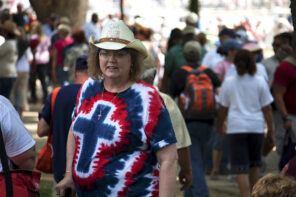How did President Barack Obama just win a second term, prevailing in evangelical (and Catholic) intensive states like Pennsylvania, Wisconsin, Iowa, Ohio, and Virginia? By winning among voters other than white religious conservatives.
If you had listened to Ralph Reed or Tony Perkins, you might have thought the mighty values voters of 2004 were going to turn out in huge numbers and tip the election to Mitt Romney. Instead, he lost, as did the Republican Party’s worst specimens in the culture wars: the rape apologists Todd Akin and Richard Mourdock. And marriage equality has passed in two states (as of this writing, Maryland and Maine), and pot was legalized in Washington and Colorado. (Brace yourself for tomorrow’s apocalyptic conference calls, emails, op-eds, and press briefings.)
But what went wrong for Reed, Perkins, et al.?
They represent a coalition in decline—white religious conservatives—while Obama has a more diverse one, made up of various religious and non-religious voters, whites, blacks, and Latinos. This story has been emerging even before the election.
The religious right made a huge mistake of hyping their clout. From two press releases yesterday:
Family Research Council’s Tony Perkins: “I would not be surprised to see tomorrow’s turnout of values voters eclipse what we saw in 2004.”
Ralph Reed’s Faith and Freedom Coalition: “The Faith and Freedom Coalition made over 122 million voter contacts to evangelicals, faithful Catholics, and other voters of faith in key states in 2012. FFC’s voter education effort included 23 million pieces of mail, 21 million get-out-the-vote calls, 18 million text messages and emails, and 30 million voter guides distributed in 117,000 churches.”
Their overblown turnout predictions either simply did not come true—or if they did, the results demonstrate that the “values voters” no longer have the clout to tip elections with their turnout. As I’ve been writing all night, based on initial exit polling data, Romney has been winning in battleground states among white evangelicals, white Catholics, and weekly churchgoers. But it wasn’t enough to give him a victory. In Pennsylvania, for example, while Romney won white Catholics and white Protestants, Obama won among Catholics as a whole, the unaffiliated, and non-white voters. In Ohio, evangelical turnout, at 31%, was higher than the evangelical proportion of the population (the Pew Religious Landscape Survey has it at 26%), so maybe Reed’s or Perkins’ GOTV worked. But the turnout wasn’t enough to push Romney over the top. Similarly, in Virginia, as I noted earlier, voters weren’t asked by exit pollsters if they were white born-again Christian or evangelical. But the exit poll had Romney winning among white Protestants, who make up 41% of voters, 75-25%, among white Catholics (11%), 64-33%, but Obama winning 89% of non-whites (33% of the electorate). Other data are showing that Obama won big among Latino voters generally.
The exit polls, like I have said, are imperfect: some states were not subjected to exit polling, and on religion questions, there’s so much inconsistency between how questions are asked in different states that it’s hard to compare two states where one includes data on evangelicals and the other does not. But given what we’ve learned recently about religious realignments—declining numbers of Catholics, declining numbers of mainline Protestants, declining numbers of evangelicals in the 18- to 29-year-old age group, and increasing numbers of unaffiliated voters, and in particular, atheists and agnostics in the 18- to 29-year-old age group—it seems like a significant shift is underway. A recent Pew survey found that there are now equal numbers of white evangelicals and unaffiliated voters, and a Public Religion Research Institute poll found similar results. I noted at the time of the PRRI survey that the bulk of Romney’s base was coming from white conservative evangelicals, mainline Protestants, and Catholics, while Obama’s “support comes from a more diverse group: 23% from the unaffiliated, 18% from black Protestants, 15% from white mainline Protestants, 14% from white Catholics, 8% from Latino Catholics, and 7% from non-Christians. Romney draws just 3% of his base from Latino Catholics, 2% from non-Christians, and an unmeasurable portion from black Protestants.”
It looks like a religious realignment is well on its way. That’s not to suggest (as I’ve said before) that the culture wars are going away. But the same narratives about “values voters” and the evangelical vote, even with its growing alignment with conservative Catholics, do not have the same explanatory—or electoral—power they once claimed.




